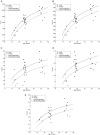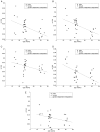Regional infant brain development: an MRI-based morphometric analysis in 3 to 13 month olds
- PMID: 22772652
- PMCID: PMC3729199
- DOI: 10.1093/cercor/bhs197
Regional infant brain development: an MRI-based morphometric analysis in 3 to 13 month olds
Abstract
Elucidation of infant brain development is a critically important goal given the enduring impact of these early processes on various domains including later cognition and language. Although infants' whole-brain growth rates have long been available, regional growth rates have not been reported systematically. Accordingly, relatively less is known about the dynamics and organization of typically developing infant brains. Here we report global and regional volumetric growth of cerebrum, cerebellum, and brainstem with gender dimorphism, in 33 cross-sectional scans, over 3 to 13 months, using T1-weighted 3-dimensional spoiled gradient echo images and detailed semi-automated brain segmentation. Except for the midbrain and lateral ventricles, all absolute volumes of brain regions showed significant growth, with 6 different patterns of volumetric change. When normalized to the whole brain, the regional increase was characterized by 5 differential patterns. The putamen, cerebellar hemispheres, and total cerebellum were the only regions that showed positive growth in the normalized brain. Our results show region-specific patterns of volumetric change and contribute to the systematic understanding of infant brain development. This study greatly expands our knowledge of normal development and in future may provide a basis for identifying early deviation above and beyond normative variation that might signal higher risk for neurological disorders.
Keywords: MRI; brain development; infant; volumetric analysis.
Figures













Similar articles
-
Regional brain volumes and their later neurodevelopmental correlates in term and preterm infants.Pediatrics. 2003 May;111(5 Pt 1):939-48. doi: 10.1542/peds.111.5.939. Pediatrics. 2003. PMID: 12728069
-
Detailed semiautomated MRI based morphometry of the neonatal brain: preliminary results.Neuroimage. 2006 Sep;32(3):1041-9. doi: 10.1016/j.neuroimage.2006.05.020. Epub 2006 Jul 20. Neuroimage. 2006. PMID: 16857388
-
Structural growth trajectories and rates of change in the first 3 months of infant brain development.JAMA Neurol. 2014 Oct;71(10):1266-74. doi: 10.1001/jamaneurol.2014.1638. JAMA Neurol. 2014. PMID: 25111045 Free PMC article.
-
Anatomical MRI of the developing human brain: what have we learned?J Am Acad Child Adolesc Psychiatry. 2001 Sep;40(9):1012-20. doi: 10.1097/00004583-200109000-00009. J Am Acad Child Adolesc Psychiatry. 2001. PMID: 11556624 Review.
-
The Infancy of the Human Brain.Neuron. 2015 Oct 7;88(1):93-109. doi: 10.1016/j.neuron.2015.09.026. Neuron. 2015. PMID: 26447575 Review.
Cited by
-
Surface-constrained volumetric registration for the early developing brain.Med Image Anal. 2019 Dec;58:101540. doi: 10.1016/j.media.2019.101540. Epub 2019 Aug 1. Med Image Anal. 2019. PMID: 31398617 Free PMC article.
-
Spatiotemporal patterns of cortical fiber density in developing infants, and their relationship with cortical thickness.Hum Brain Mapp. 2015 Dec;36(12):5183-95. doi: 10.1002/hbm.23003. Epub 2015 Sep 29. Hum Brain Mapp. 2015. PMID: 26417847 Free PMC article.
-
CerebroMatic: A Versatile Toolbox for Spline-Based MRI Template Creation.Front Comput Neurosci. 2017 Feb 22;11:5. doi: 10.3389/fncom.2017.00005. eCollection 2017. Front Comput Neurosci. 2017. PMID: 28275348 Free PMC article.
-
Variation of the slope of the tentorium during childhood.Childs Nerv Syst. 2016 Mar;32(3):441-50. doi: 10.1007/s00381-015-2899-8. Epub 2015 Sep 11. Childs Nerv Syst. 2016. PMID: 26362679
-
Voxelwise and Regional Brain Apparent Diffusion Coefficient Changes on MRI from Birth to 6 Years of Age.Radiology. 2021 Feb;298(2):415-424. doi: 10.1148/radiol.2020202279. Epub 2020 Dec 8. Radiology. 2021. PMID: 33289612 Free PMC article.
References
-
- Barkovich AJ. Magnetic resonance techniques in the assessment of myelin and myelination. J Inherit Metab Dis. 2005;28(3):311–343. doi:10.1007/s10545-005-5952-z. - DOI - PubMed
-
- Bohbot VD, Kalina M, Stepankova K, Spackova N, Petrides M, Nadel L. Spatial memory deficits in patients with lesions to the right hippocampus and to the right parahippocampal cortex. Neuropsychologia. 1998;36:1217–1238. doi:10.1016/S0028-3932(97)00161-9. - DOI - PubMed
-
- Burgess N, Maguire EA, O'Keefe J. The human hippocampus and spatial and episodic memory. Neuron. 2002;35:625–641. doi:10.1016/S0896-6273(02)00830-9. - DOI - PubMed
-
- Castellanos FX, Giedd JN, Marsh WL, Hamburger SD, Vaituzis AC, Dickstein DP, Sarfatti SE, Vauss YC, Snell JW, Lange N, et al. Quantitative brain magnetic resonance imaging in attention-deficit hyperactivity disorder. Arch Gen Psychiatry. 1996;53(7):607–616. doi:10.1001/archpsyc.1996.01830070053009. - DOI - PubMed
Publication types
MeSH terms
Grants and funding
LinkOut - more resources
Full Text Sources
Other Literature Sources
Medical

